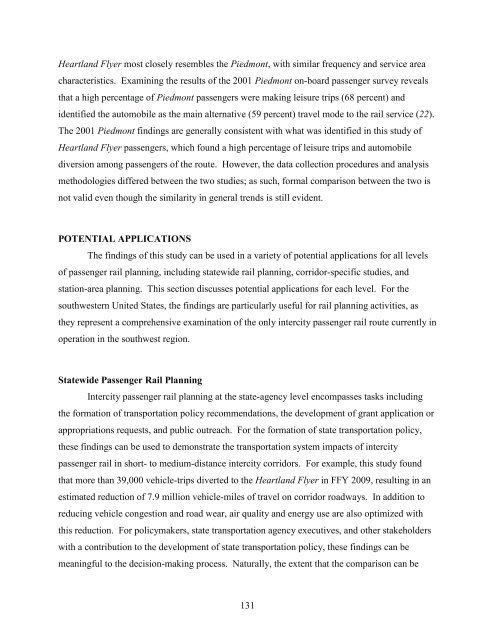Measuring the Benefits of Intercity Passenger Rail: A Study
Measuring the Benefits of Intercity Passenger Rail: A Study
Measuring the Benefits of Intercity Passenger Rail: A Study
You also want an ePaper? Increase the reach of your titles
YUMPU automatically turns print PDFs into web optimized ePapers that Google loves.
Heartland Flyer most closely resembles <strong>the</strong> Piedmont, with similar frequency and service area<br />
characteristics. Examining <strong>the</strong> results <strong>of</strong> <strong>the</strong> 2001 Piedmont on-board passenger survey reveals<br />
that a high percentage <strong>of</strong> Piedmont passengers were making leisure trips (68 percent) and<br />
identified <strong>the</strong> automobile as <strong>the</strong> main alternative (59 percent) travel mode to <strong>the</strong> rail service (22).<br />
The 2001 Piedmont findings are generally consistent with what was identified in this study <strong>of</strong><br />
Heartland Flyer passengers, which found a high percentage <strong>of</strong> leisure trips and automobile<br />
diversion among passengers <strong>of</strong> <strong>the</strong> route. However, <strong>the</strong> data collection procedures and analysis<br />
methodologies differed between <strong>the</strong> two studies; as such, formal comparison between <strong>the</strong> two is<br />
not valid even though <strong>the</strong> similarity in general trends is still evident.<br />
POTENTIAL APPLICATIONS<br />
The findings <strong>of</strong> this study can be used in a variety <strong>of</strong> potential applications for all levels<br />
<strong>of</strong> passenger rail planning, including statewide rail planning, corridor-specific studies, and<br />
station-area planning. This section discusses potential applications for each level. For <strong>the</strong><br />
southwestern United States, <strong>the</strong> findings are particularly useful for rail planning activities, as<br />
<strong>the</strong>y represent a comprehensive examination <strong>of</strong> <strong>the</strong> only intercity passenger rail route currently in<br />
operation in <strong>the</strong> southwest region.<br />
Statewide <strong>Passenger</strong> <strong>Rail</strong> Planning<br />
<strong>Intercity</strong> passenger rail planning at <strong>the</strong> state-agency level encompasses tasks including<br />
<strong>the</strong> formation <strong>of</strong> transportation policy recommendations, <strong>the</strong> development <strong>of</strong> grant application or<br />
appropriations requests, and public outreach. For <strong>the</strong> formation <strong>of</strong> state transportation policy,<br />
<strong>the</strong>se findings can be used to demonstrate <strong>the</strong> transportation system impacts <strong>of</strong> intercity<br />
passenger rail in short- to medium-distance intercity corridors. For example, this study found<br />
that more than 39,000 vehicle-trips diverted to <strong>the</strong> Heartland Flyer in FFY 2009, resulting in an<br />
estimated reduction <strong>of</strong> 7.9 million vehicle-miles <strong>of</strong> travel on corridor roadways. In addition to<br />
reducing vehicle congestion and road wear, air quality and energy use are also optimized with<br />
this reduction. For policymakers, state transportation agency executives, and o<strong>the</strong>r stakeholders<br />
with a contribution to <strong>the</strong> development <strong>of</strong> state transportation policy, <strong>the</strong>se findings can be<br />
meaningful to <strong>the</strong> decision-making process. Naturally, <strong>the</strong> extent that <strong>the</strong> comparison can be<br />
131
















